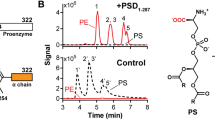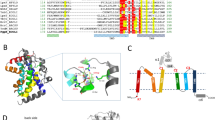Abstract
An isogenic pair of Escherichia coli strains lacking (pssA) and possessing (wild-type) the enzyme phosphatidylserine synthase was used to estimate the effects of the total lack of phosphatidylethanolamine (PE), the major phospholipid in E. coli membranes, on the activities of several sugar permeases (enzymes II) of the phosphoenolpyruvate:sugar phosphotransferase system (PTS). The mutant exhibits greatly elevated levels of phosphatidylglycerol (PG), a lipid that has been reported to stimulate the in vitro activities of several PTS permeases. The activities, thermal stabilities, and detergent sensitivities of three PTS permeases, the glucose enzyme II (IIGlc), the mannose enzyme II (IIMan) and the mannitol enzyme II (IIMtl), were characterized. Western blot analyses revealed that the protein levels of IIGlc were not appreciably altered by the loss of PE. In the pssA mutant, IIGlc and IIMan activities were depressed both in vivo and in vitro, with the in vivo transport activities being depressed much more than the in vitro phosphorylation activities. IIMtl also exhibited depressed transport activity in vivo but showed normal phosphorylation activities in vitro. IIMan and IIGlc exhibited greater thermal lability in the pssA mutant membranes than in the wild-type membranes, but IIMtl showed enhanced thermal stability. All three enzymes were activated by exposure to TritonX100 (0.4%) or deoxycholate (0.2%) and inhibited by SDS (0.1%), but IIMtl was the least affected. IIMan and, to a lesser degree, IIGlc were more sensitive to detergent treatments in the pssA mutant membranes than in the wild-type membranes while IIMtl showed no differential effect. The results suggest that all three PTS permeases exhibit strong phospholipid dependencies for transport activity in vivo but much weaker and differential dependencies for phosphorylation activities in vitro, with IIMan exhibiting the greatest and IIMtl the least dependency. The effects of lipid composition on thermal sensitivities and detergent activation responses paralleled the effects on in vitro phosphorylation activities. These results together with those previously published suggest that, while the in vivo transport activities of all PTS enzymes II require an appropriate anionic to zwitterionic phospholipid balance, the in vitro phosphorylation activities of these same enzymes show much weaker and differential dependencies. Alteration of the phospholipid composition of the membrane thus allows functional dissection of transport from the phosphorylation activities of PTS enzyme complexes.






Similar content being viewed by others
References
Aboulwafa M, Saier MH Jr (2002) Dependency of sugar transport and phosphorylation by the phosphoenolpyruvate-dependent phosphotransferase system on membranous phosphatidyl glycerol in Escherichia coli: Studies with a pgsA mutant lacking phosphatidyl glycerophosphate synthase. Res Microbiol 153:667–677
Abramson J, Smirnova I, Kasho V, Verner G, Kaback HR, Iwata S (2003) Structure and mechanism of the lactose permease of Escherichia coli. Science 301:610–615
Bogdanov M, Dowhan W (1995) Phosphatidylethanolamine is required for in vivo function of the membrane-associated lactose permease of Escherichia coli. J Biol Chem 270:732–739
Bogdanov M, Dowhan W (1998) Phospholipid-assisted protein folding: phosphatidyl-ethanolamine is required at a late step of the conformational maturation of the polytopic membrane protein lactose permease. EMBO J 17:5255–5264
Bogdanov M, Umeda M, Dowhan W (1999) Phospholipid-assisted refolding of an integral membrane protein. Minimal structural features for phosphatidylethanolamine to act as a molecular chaperone. J Biol Chem 274:12339–12345
Bogdanov M, Heacock PN, Dowhan W (2002) A polytopic membrane protein displays a reversible topology dependent on membrane lipid composition. EMBO J 21:2107–2116
Chen CC, Wilson TH (1984) The phospholipid requirement for activity of the lactose carrier of Escherichia coli. J Biol Chem 259:10150–10158
DeChavigny A, Heacock PN, Dowhan W (1991) Sequence and inactivation of the pss gene of Escherichia coli. Phosphatidylethanolamine may not be essential for cell viability. J Biol Chem 266:5323–5332
Dowhan W (1997) Molecular basis for membrane phospholipid diversity: why are there so many lipids? Annu Rev Biochem 66:199–232
Dowhan W (1998) Genetic analysis of lipid-protein interactions in Escherichia coli membranes. Biochim Biophys Acta 1376:455–466
Garcia-Alles LF, Zahn A, Erni B (2002) Sugar recognition by the glucose and mannose permeases of Escherichia coli. Steady-state kinetics and inhibition studies. Biochemistry 41:10077–10086
Huang Y, Lemieux MJ, Song J, Auer M, Wang D-N (2003) Structure and mechanism of the glycerol-3-phosphate transporter from Escherichia coli. Science 301:616–620
Kikuchi S, Shibuya I, Matsumoto K (2000) Viability of an Escherichia coli pgsA null mutant lacking detectable phosphatidylglycerol and cardiolipin. J Bacteriol 182:371–376
Kundig W, Roseman S (1971) Sugar transport. II. Characterization of constitutive membrane-bound enzymes II of the Escherichia coli phosphotransferase system. J Biol Chem 246:1407–1418
Leonard JE, Saier MH Jr (1983) Mannitol-specific enzyme II of the bacterial phosphotransferase system II. Reconstitution of vectorial transphosphorylation in phospholipid vesicles. J Biol Chem 258:10757–10760
Locher KP, Bass RB, Rees DC (2003) Breaching the barrier. Science 301:603–604
Mao Q, Schunk T, Flukiger K, Erni B (1995) Functional reconstitution of the purified mannose phosphotransferase system of Escherichia coli into phospholipids vesicles. J Biol Chem 270:5258–5265
Matsumoto K (2001) Dispensable nature of phosphatidylglycerol in Escherichia coli. Dual roles of anionic phospholipids. Mol Microbiol 39:1427–1433
Mileykovskaya EI, Dowhan W (1993) Alterations in the electron transfer chain in mutant strains of Escherichia coli lacking phosphatidylethanolamine. J Biol Chem 268:24824–24831
Mileykovskaya E, Sun Q, Margolin W, Dowhan W (1998) Localization and function of early cell division proteins in filamentous Escherichia coli cells lacking phosphatidylethanolamine. J Bacteriol 180:4252–4257
Opekarova M, Tanner W (2003) Specific lipid requirements of membrane proteins—a putative bottleneck in heterologous expression. Biochim Biophys Acta 1610:11–22
Postma PW, Lengeler JW, Jacobson GR (1996) Phosphoenolpyruvate:carbohydrate phosphotransferase systems. In Neidhardt FC et al. (eds) Escherichia coli and Salmonella. Cellular and molecular biology, 2nd edn, vol 1. ASM Press, Washington DC, pp. 1149–1174
Robillard GT, Lolkema JS (1988) Enzymes II of the phosphoenolpyruvate-dependent sugar transport systems: a review of their structure and mechanism of sugar transport. Biochim Biophys Acta 947:493–519
Robillard GT, Broos J (1999) Structure/function studies on the bacterial carbohydrate transporters, enzymes II, of the phosphoenolpyruvate-dependent phosphotransferase system. Biochim Biophys Acta 1422:73–104
Roossien FF, Blaauw M, Robillard GT (1984) Kinetics and subunit interaction of the mannitol-specific enzyme II of the Escherichia coli phosphoenolpyruvate-dependent phosphotransferase system. Biochemistry 23:4934–4939
Saier MH Jr, Newman MJ (1976) Direct transfer of the phosphoryl moiety of mannitol 1-phosphate to [14C]mannitol catalyzed by the enzyme II complexes of the phosphoenolpyruvate:mannitol phosphotransferase systems in Spirochaeta aurantia and Salmonella typhimurium. J Biol Chem 251:3834–3837
Saier MH Jr, Schmidt MR (1981) Vectorial and nonvectorial transphosphorylation catalyzed by enzymes II of the bacterial phosphotransferase system. J Bacteriol 145:391–397
Saier MH Jr, Cox DF, Moczydlowski EG (1977a) Sugar phosphate:sugar transphosphorylation coupled to exchange group translocation catalyzed by the enzyme II complexes of the phosphoenolpyruvate:sugar phosphotransferase system in membrane vesicles of Escherichia coli. J Biol Chem 252:8908–8916
Saier MH Jr, Feucht BU, Mora WK (1977b) Sugar phosphate:sugar transphosphorylation and exchange group translocation catalyzed by the enzyme II complexes of the bacterial phosphoenolpyruvate:sugar phosphotransferase system. J Biol Chem 252:8899–8907
Sambrook J, Fritsch EF, Maniatis T (1989) Molecular cloning: a laboratory manual, 2nd edn. Cold Spring Harbor Laboratory, Cold Spring Harbor, New York
Seto-Young D, Chen CC, Wilson TH (1985) Effect of different phospholipids on the reconstitution of two functions of the lactose carrier of Escherichia coli. J Membr Biol 84:259–267
Shi W, Bogdanov M, Dowhan W, Zusman DR (1993) The pss and psd genes are required for motility and chemotaxis in Escherichia coli. J Bacteriol 175:7711–7714
Suzuki M, Hara H, Matsumoto K (2002) Envelope disorder of Escherichia coli cells lacking phosphatidylglycerol. J Bacteriol 184:5418–5425
Wang X, Bogdanov M, Dowhan W (2002) Topology of polytopic membrane protein subdomains is dictated by membrane phospholipid composition. EMBO J 21:5673–5681
Acknowledgments
We thank Dr. W. Dowhan for the bacterial strains used in this study, Dr. B. Erni for the antibody and control strains used for the Western blot analysis, and both of these professors for valuable discussions. Mary Beth Hiller provided assistance in the preparation of this manuscript. This work was supported by NIH grant GM64368 from the Institute of General Medical Sciences.
Author information
Authors and Affiliations
Corresponding author
Rights and permissions
About this article
Cite this article
Aboulwafa, M., Hvorup, R. & Saier, M.H. Dependency of sugar transport and phosphorylation by the phosphoenolpyruvate-dependent phosphotransferase system on membranous phosphatidylethanolamine in Escherichia coli: studies with a pssA mutant lacking phosphatidylserine synthase. Arch Microbiol 181, 26–34 (2004). https://doi.org/10.1007/s00203-003-0623-7
Received:
Revised:
Accepted:
Published:
Issue Date:
DOI: https://doi.org/10.1007/s00203-003-0623-7




